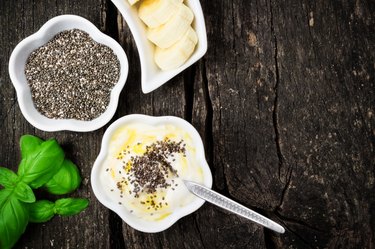
Basil seeds are touted as the newest superfood, a replacement for those tired old chia seeds you swirl into your smoothies and oatmeal. With similar nutrient profiles, they just might be. Like chia, basil seeds are rich in fiber and may suppress your appetite to help you fill up on fewer calories.
What Are Basil Seeds?
Video of the Day
Most people know and love the leaves of the basil plant for their fragrant addition to sauces and pizza. The seeds are less celebrated. However, they have been used in traditional medicine to treat a range of conditions, primarily digestive, such as ulcers, heartburn and diarrhea.
Video of the Day
The seeds, also sometimes known as sabja seeds, are popular in Southern Asia, where they are used to provide a unique texture to traditional beverages, such as sharbat, and to iced desserts like falooda. They provide a chewy, slippery texture similar to the tapioca balls used in bubble tea.
Basil seeds provide significant amounts of the minerals magnesium, iron, manganese and zinc and healthy fats, reports a research article published in the Pakistan Journal of Agricultural Research in September 2017. They are also a rich source of phenols — naturally occurring chemicals in plants with antioxidant properties.
Read more: 7 Sneaky Ways to Get the Fiber You Need
Fiber and Weight Loss
Basil seeds trump chia seeds when it comes to fiber content, with 7 grams per tablespoon, compared to 4 grams in a tablespoon of chia, per USDA data. This is where they can play an important role in weight loss.
Eating more fiber is an established healthy strategy for weight loss. Fiber digests slowly and slows the digestion of other foods eaten with it. Therefore, food stays in your stomach longer after you finish eating. This may help you stretch the time between meals and consume fewer calories at your next meal.
Fiber-rich foods are also typically less energy-dense, meaning they contain fewer calories ounce for ounce than low-fiber foods. You can consume more food and still control your calorie intake when you choose foods that are higher in fiber, explains the Centers for Disease Control and Prevention.
Read more: 19 High-Fiber Foods — Some May Surprise You!
Special Role of Soluble Fiber
Like chia seeds, basil seeds are particularly high in a type of fiber called soluble fiber. As its name suggests, soluble fiber dissolves in water. As it attracts fluids in the gut, it swells, causing the stomach to become distended. If you've ever had a "food baby" after a large meal, you're familiar with this concept.
You probably didn't feel hungry again anytime soon afterward. This may have had to do with an appetite-stimulating hormone called ghrelin. According to a review article in the Journal of Nutrition & Metabolism in January 2019, stomach distension delays the release of ghrelin. The longer the stomach remains distended, the longer the delay.
Additionally, soluble fiber is fermented in the gut by microflora, a process that produces short-chain fatty acids (SCFAs), including acetic, propionic and butyric acid. According to a research review published in Advances in Nutrition in July 2019, SCFAs stimulate the release of satiety hormones that suppress hunger.
Ways to Eat Basil Seeds
You can include basil seeds in your diet in most of the same ways you eat chia seeds. Add them whole or ground to smoothies, juices, yogurt or oatmeal. Sprinkle them on top of a salad for a little crunch. You can also make basil seed pudding by combining basil seeds with coconut milk. Add some natural sweetness with fruit of your choice and let the seeds soak for at least 20 minutes.
While the fiber content of basil seeds is a bonus, be careful to not go overboard. Increasing your fiber intake too quickly can cause digestive distress. Start with one-half tablespoon and gradually increase your serving size over a couple of weeks.
- Pakistan Journal of Agricultural Research: "Nutritional Assessment of Basil Seed and Its Utilization in Development of Value Added Beverage"
- USDA FoodData Central: "Seeds, Chia Seeds, Dried"
- ZenBasil: "Raw Basil Seeds"
- Centers for Disease Control and Prevention: "Low-Energy-Dense Foods and Weight Management: Cutting Calories While Controlling Hunger"
- Journal of Nutrition & Metabolism: "The Role of Fiber in Energy Balance"
- Advances in Nutrition: "Perspective: Physiologic Importance of Short-Chain Fatty Acids From Nondigestible Carbohydrate Fermentation"
- Times of India: "What Are Sabja Seeds and Why They Have Suddenly Become Popular"
- Harvard T.H. Chan School of Public Health: "Chia Seeds"